Motions in Civil Cases
When a party needs an order from the judge, they can file a motion. They must use specific formats and follow particular timelines to do so. The other side can file an Opposition to the motion explaining why the judge should not grant the order, and must also follow the formats and time requirements. The moving party can choose to file a Reply to the opposition. This guide discusses those requirements and gives examples of how a motion, opposition, or reply could look.
Templates and Forms
- Motion (Generic) Template – RTF
- Opposition or Reply (Generic) Template – RTF
- Order Granting Motion (Generic) Template – RTF
Writing, Scheduling, and Opposing Motions
There are no pre-printed Judicial Council forms for most civil motions, so you must draft them yourself. Motions must follow a very specific format.
Occasionally a Motion, Opposition, or Reply will require additional sections, such as a Request for Judicial Notice, a Separate Statement of Undisputed Facts, or a copy of a proposed pleading. For examples, see our Request for Judicial Notice form and our Relief from Default Judgment guide. These are usually filed at the same time as the Motion but as separate documents.
Terms to Know
Motions: papers filed to ask the judge to make a court order in an existing case, to explain why the moving party is legally entitled to the order, and to set up a hearing date for oral argument and the decision. Minimum advance notice: 16+5: sixteen court (business) days before hearing plus five calendar days for mail service on other party.
Opposition: papers filed by the opposing party to object to a motion. Deadline to file: nine court (business) days before hearing. Service must be by personal service or overnight mail on the day you file.
Reply: optional paper to respond to the Opposition. Deadline to file: five court (business) days before hearing. Service must be by personal service or overnight mail on the day you file.
Oral Argument: On the hearing date, the parties go to court to make their arguments and answer questions from the judge. In most departments, the judge makes a tentative ruling on the court day before the hearing, and the oral argument is cancelled unless one of the parties calls the court to confirm that they want to appear and argue their case.
Tentative Ruling: at 2 p.m. on the court day before the hearing, the judge posts a preliminary decision (“tentative ruling”) on the Sacramento Court’s website. Each party must read it and decide whether to appear for oral argument. The oral argument is canceled unless one of the parties calls the court to confirm between 2 p.m. and 4 p.m. on the court day before the hearing. If no call is made, the Tentative Ruling becomes the order of the court. Sacramento Local Rule (Local Rule) 1.06.
Court Order: The final decision of the court. If no oral argument is held, the Tentative Ruling becomes the official court order. If oral argument is held, the court order may be issued at the end of the hearing or may be mailed out some time later.
Court Reporter: In Sacramento, there are no court reporters in most civil cases unless a party arranges and pays for the service ahead of time. In some courtrooms, there is an audio recording which can be transcribed later, but not in Departments 53 or 54.
Guides for Particular Motions
This guide should be useful for most types of civil motions, but the Law Library has prepared guides for many specific situations. Some popular ones are:
- Motion to Vacate or Set Aside (Relief from Default Judgment)
- Motion to Pay Judgment in Installments
- Motion to Compel Discovery Responses
- Motion to Deem Facts Admitted
For more, visit our “Search by Topic” page. Search or click on your topic of interest, then scroll down to “Research Guides.”
Warning! Do not use this guide for Demurrers or Summary Judgment/Adjudication motions. They are very complex and follow different rules and deadlines.
Required Parts of All Motions
A Motion has three required parts, and an optional fourth:
- Notice of Motion and Motion (date, time, and location of hearing, and a brief statement of the request);
- Memorandum of Points and Authorities (legal argument);
- Declaration(s) (evidence); and
- Proposed Order (usually optional, but recommended.)
The Notice of Motion and Motion, Memorandum of Points and Authorities, and Declaration(s) may be filed as separate documents or combined together into the same document. The template and samples in this Guide combine them into one. The Proposed Order (if included) is always filed as a separate document. California Rule of Court (CRC) 3.1112.
Opposition and Reply papers usually have two parts:
- Memorandum of Points and Authorities (legal argument); and
- Declaration(s) (evidence), if needed.
Oppositions and Replies do not include a Notice of Motion and Motion or a Proposed Order. The Memorandum of Points and Authorities and Declaration(s) may be filed as separate documents or combined together into the same document. The template and samples in this Guide combine them into one.
Required Format: Court papers must be written on 28-line “pleading paper,” in the format required by CRC 2.100-2.119. The first page must display a caption containing specific information. Each line must be numbered. Each page must have a footer with the page number and title of the document. Type style and size, margins, and line spacing are all specified. The templates accompanying this guide satisfy these requirements.
Notice of Motion and Motion
Notice of Motion and Motion: The Notice of Motion and Motion specifies the date, time, and location where the hearing will take place, spells out what the party is requesting, and gives a very brief citation to the law supporting the request. In Sacramento, the Notice of Motion and Motion must include the paragraph from Local Rule 1.06 (D) informing the parties of the tentative ruling system.
Memorandum of Points and Authorities
Memorandum of Points and Authorities: The phrase “Points and Authorities” refers to legal arguments and the cases, statutes, or regulations supporting them (also called “authorities”). The parties must explain the law and how it applies to the facts of their case. This portion of the Motion, Opposition, or Reply usually requires original research, analysis, and writing, although the Law Library has many resources to get you started. Particularly good starting places are listed at the end of this guide.
There is a page limit of 15 pages for Motions and Oppositions, and 10 pages for Replies. These limits do not count declarations, exhibits, or proofs of service. (CRC 3.1113(d)). Any memorandum over 10 pages must have a table of contents and table of authorities; these are not covered in this Guide. (CRC 3.1113(f)).
Declaration and Evidence
Declaration: The parties must provide some factual basis (evidence) for their arguments. This is generally done by attaching a Declaration, written by someone with first-hand knowledge of the facts, explaining the facts in numbered paragraphs. The facts are usually cited by paragraph number in the Memorandum of Points and Authorities. For example, in his Declaration, defendant David Jones might write:
13. On July 3, 2013, I purchased a 2010 Toyota Camry, VIN 2894320, from plaintiff Smith’s Used Car Lot.
In the Memorandum of Points and Authorities, Jones would write:
On July 3, 2013, defendant purchased a 2010 Toyota Camry, VIN 2894320, from plaintiff Smith’s Used Car Lot. (Jones Decl., Para. 13.)
Documents, photographs, and other attachments can be used as evidence. Attach such documents to a Declaration as exhibits. In the Declaration, identify the attachment with language such as “On July 3, 2013, I signed a Vehicle Purchase Contract. A true and correct copy of the contract is attached as Exhibit “A” to this Declaration.” Photocopy the attachment and write “Exhibit A” on the bottom of the page. (The second exhibit is “Exhibit B,” and so on.) If the exhibit is longer than one page, number each page A‑1, A‑2, A‑3, and so forth. Attach the exhibits to the end of the Declaration.
Note: Declarations and exhibits must meet legal requirements to be admitted in court, which are not covered in this Guide. For information about the requirements for different types of evidence, see “A Short Course in the Rules of Evidence,” in Chapter 13 of the self-help book Win Your Lawsuit. A useful discussion of the types of evidence that can be used to support motions and applications can be found at 14:490-498 of California Pretrial Practice & Forms from James Publishing.
Proposed Order
Proposed Order: While usually not required, it is advisable to include a Proposed Order with most Motions. If the order is served along with the motion, the judge can sign it immediately after making a decision. Oppositions and Replies do not need a Proposed Order.
Step-by-Step Instructions
If you are the party filing the motion (the “moving party”), start at Step 1. If you are the party the motion is filed against (the “opposing party”), you do not need to schedule the hearing and should start at Step 2.
1
Schedule the Hearing
This information is for Sacramento. If your case is in a different county, do not follow these instructions. Instead, call the clerk or visit the court website in your county to find the correct information.
Determine the department and time of the motion
In Sacramento, most motions are heard in the “Civil Home Court” department assigned to the case, which will be either department 25, 28, 53, or 54. Check your case file online to find which department your case is assigned to.
Note: Prior to November 10, 2025, each civil case was assigned to either Department 53 or 54 for most motions. If your case was filed before that date, its assigned department may have changed, so check before scheduling a hearing.
More information about Civil Home Court department transition
A few types of motions are heard in other departments. Check which departments hear which types of motions in Sacramento on the Civil Motions webpage.
Reserve the date for the hearing
In the Civil Home Departments, you must reserve a court date through the court’s online reservation system. For other departments, contact the department clerk to determine the procedure.
To use the online system, go to the Sacramento Court Public Portal and choose “Reservation System (CRS).” You must have a free account on the system to use it.
Before you log on or call, figure out if there are any days you will not be available during the next couple of months. For instance, you don’t want to pick a date when you know you will be out of town.
You must choose a date far enough in the future that you can both file and serve your motion on time. Scheduling it four weeks in advance generally gives a comfortable margin for most types of motions. Usually, the first available date will be further away than that.
Determine the legal deadline to file the motion in court
Disclaimer! Some motions have different time requirements. Check the rules for the motion you are filing.
Tip: File the motion as soon as possible. Your reservation is not final until the motion has been filed and any fees paid.
The last legal day to file with the court is at least sixteen court (business) days prior to the motion date (CCP § 1005). “Court days” are Monday through Friday, excluding court holidays.
NOTE: the court must receive the documents by that day. Postmark will not count.
To determine whether a particular filing date will meet this deadline, start counting backwards on the day before your hearing until you reach the sixteenth court day. (CCP § 12c)
For example, suppose your reservation is for Monday, June 18. You would start counting backward using the previous court day, Friday, June 15, as day one, as shown in the calendar below. Skip weekends and court holidays (there is one court holiday in this example, which is Memorial Day, May 28). The sixteenth court day before the hearing would be May 24, which would be the last day that the motion could be filed.
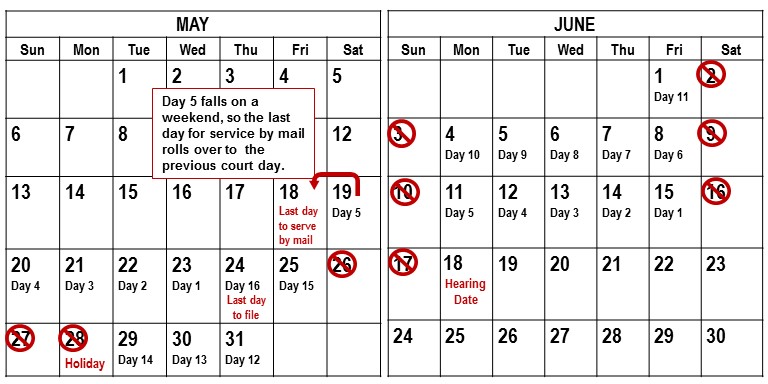
Make a note on your calendar to file the motion by this date. Do not miss this deadline. The court will cancel the hearing and you will have to start over.
Determine the legal deadline to serve the motion on the other parties or their attorneys
You must have a copy of the motion served on all other attorneys (or self-represented parties) by a strict deadline set by law. Earlier is always fine.
Personal service: 16 court days before the hearing, the same as the minimum filing deadline. The server should fill out Proof of Personal Service—Civil (POS-020).
Service by mail: 16 court days before hearing PLUS five calendar days before the hearing (more if the mailing address is outside California). (CCP § 1005). The server should fill out Proof of Service by First-Class Mail—Civil.
“Court days” are business days – Monday – Friday, except holidays.
“Calendar days” include weekends and holidays, but if the final day lands on a weekend or holiday, it is pushed back to the previous court day.
Make a note on your calendar to have the motion served by mail before the mail deadline. If you miss the mail deadline, you can still have the motion served by personal service up until 16 court days before the hearing. If you miss that deadline, you will have to cancel your court date and start over.
2
Research and Write the Motion, Opposition, or Reply
Moving parties continue here.
The moving party must include a Notice of Motion and Motion, which specifies the date, time, and location where the hearing will take place, spells out what the party is requesting, and gives a very brief citation to the law supporting the request.
Note that in Sacramento, the Notice of Motion and Motion must include notification of the Tentative Ruling system if the department issues tentative rulings (not all do). If the hearing is in the Law and Motion departments (Departments 53 and 54), the paragraph from Local Rule 1.06 (D) is required. In other departments, check with the clerk to learn what is required.
The customizable Motion template linked at the top of this guide includes the necessary language for Departments 53 and 54.
Begin here if you are preparing an Opposition or a Reply.
The rest of the motion consists of a Memorandum and Declaration with exhibits. Opposition papers and replies do not need a Notice of Motion and Motion, but the rest of their requirements are identical, so this part of the guide covers them together.
There are no Judicial Council forms for most civil motions, oppositions, or replies. Instead, the relevant documents must be typed on 28-line pleading paper. The customizable templates linked at the top of this guide are already in the correct format.
In your Memorandum, you must explain the law, demonstrate how it applies to your case, and (in Oppositions and Replies) show why the other party’s argument is wrong. This usually requires original research, analysis, and writing. At the end of this guide, you will find a list of reference books with good starting points for civil motion research.
The Reply is generally limited to responding to the points made in the Opposition instead of introducing new arguments or evidence.
Each type of filing requires a Declaration in which you state the facts under penalty of perjury, and attach any documents or photos you want the judge to consider. This becomes the evidence the judge uses to decide the motion. For tips and examples of how to write a declaration, see our article “Declaration Tips.“
Information for Opposing Parties
Written Opposition is required. Going to the hearing is not sufficient. If you do not file a written Opposition on time, the judge will probably grant the Motion and cancel the hearing.
What if you can’t attend on the hearing date? Call the other party RIGHT AWAY and ask them to re-schedule. If they refuse, you can file a motion or ex parte application asking the judge to postpone (“continue”) the hearing, but you must have a very good reason, like pre-paid plane tickets.
What if you agree with the Motion? Call the other party and offer to sign a stipulation. Usually the Motion can then be canceled (“taken off calendar”).
At the end of this Guide are a sample Motion and a sample Opposition, completed by the hypothetical parties “Petra Plaintiff” and “Doug Defendant.”
3
Make Copies of your Documents
Make at least two copies of your Motion, Opposition, or Reply and your Proposed Order, if any. Staple each of the copies, but leave the original unstapled so it can easily be scanned into the court’s file system.
One of these copies is to be served on the other party’s attorney (or the other party, if they do not have an attorney). If there is more than one other party, make one copy for each party. The original is to be filed with the court, along with one copy for the clerk to stamp (“endorse”) and return to you.
Attaching Exhibits
For each exhibit attached to your motion, you must place a page in front of the exhibit identifying it as Exhibit A, B, and so forth in alphabetical order.
4
Have Your Documents Served on the Attorney(s) or Self-Represented Party(s)
You must serve your papers on all other attorneys or self-represented parties in the case by specified deadlines. Earlier is fine.
- Motions: 16 court days before hearing (+5 calendar days for mailing). If the mailing deadline (16+5 days) has passed, but there are still more than 16 court days before the hearing, you can have it served by personal delivery. If you miss the service deadline entirely, you will need to re-schedule your motion.
- Oppositions and Replies: serve on the day you file, using a form of service that will get the papers to the other party by end of business the next day. For example, you can have them served via overnight delivery, messenger, or personal delivery. If the parties have agreed in writing to accept service by fax or email, you can use those methods.
Your server can use the Judicial Council form Proof of Service – Civil (POS‑040), which has checkboxes for all of these methods, or any other appropriate Proof of Service form. The form should be completely filled out at this point, but not signed. Make a copy of the unsigned proof of service before proceeding.
The server must serve a copy of the papers, along with a copy of the unsigned proof of service form, to the opposing attorney(s) or self-represented litigant(s). The unsigned proof of service form can be attached as the last page of the Motion, Opposition, or Reply.
The person doing the serving then signs the Proof of Service form, and gives the signed Proof of Service to you.
If you are filing an optional copy to be endorsed and returned, make a copy of the signed Proof of Service. It is not necessary to copy the instruction page.
5
Assemble your Documents for Filing
Assemble your packet for filing as follows. The original should be unstapled, while the copy is stapled.
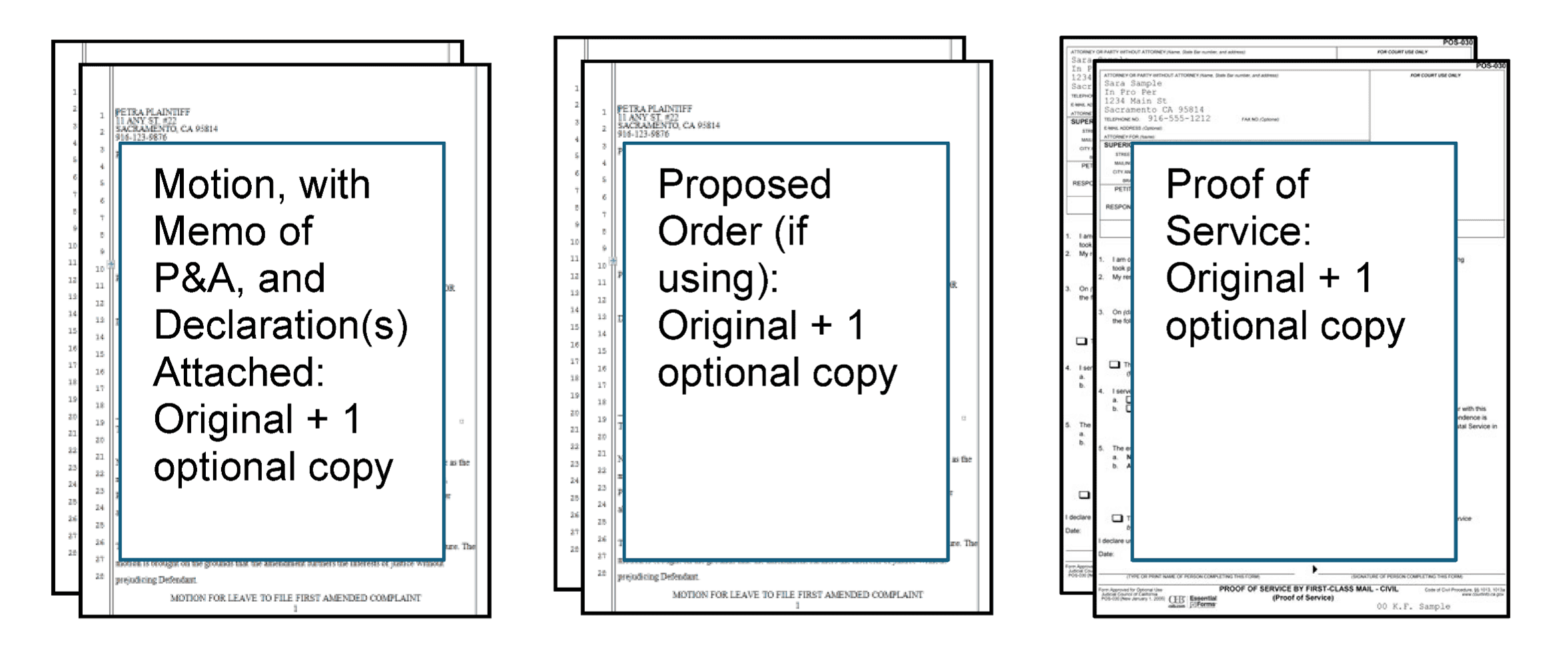
- Motion, Opposition or Reply, including Memorandum of Points and Authorities and Declaration with exhibits: original plus one optional copy.
- Proposed Order, if included, plus one optional copy.
- Completed Proof of Service form: The original plus one optional copy. This proof of service can filed as its own document, or it can be attached as the last page of the Motion, Opposition or Reply when filing. If it is attached, then attach the original Proof of Service to the original Motion, Opposition or Reply, and the copy of the Proof of Service should be attached to the copy of the Motion, Opposition or Reply.
- Any other documents, such as Request for Judicial Notice, should be treated the same way: create a stack of original plus one optional copy and file along with the others.
6
File at 813 6th St. Room 212; Moving Party Pays Fee
Most Motions, Oppositions, and Replies are filed at the Hall of Justice building, 813 6th St. (6th and H). Check the “Overview of Which Departments Hear Civil Matters” page to see if your motion needs to be filed elsewhere.
At this time there is a $60 filing fee for a motion, unless your fees were waived. There is no fee for filing an opposition or reply.
7
Review Tentative Ruling at 2 p.m. the Court Day Before the Hearing; Schedule Argument by 4 p.m. if Necessary
Pursuant to Local Rule 1.06, the court in most departments makes a tentative ruling on the motion by 2:00 p.m. the court day before the hearing. You then have two hours to request oral argument, if you choose to do so.
Warning!
Your hearing will be canceled
If neither you nor the other party calls the court, the hearing will be canceled and you will not be permitted to talk to the judge.
You may read the tentative ruling on your case’s page in the court’s Public Portal, or call the assigned department to hear it. For more information, see the Sacramento County Superior Court’s Civil Tentative Rulings page.
Closely review the Tentative Ruling. If you are making the motion, you are looking for your motion to be “GRANTED.” If you are opposing the motion, you are looking for the motion to be “DENIED.” The motion may also be “GRANTED IN PART” and “DENIED IN PART.” The judge sometimes orders the parties to appear, even if neither party requests oral argument.
Losing party: If you are not happy with the Tentative Ruling, and wish to present oral argument in front of the judge, you must call the clerk for the department and all other attorneys and/or self-represented parties, no later than 4:00 p.m. the court day before your hearing and state that you are requesting oral argument. Note: carefully consider whether it is worth your time to request oral argument. It is very rare for judges to change their mind, but it does happen sometimes.
Winning party: If you are happy with the Tentative Ruling, you do not need to do anything unless the Tentative Ruling orders you to appear, or the other side calls you before 4:00 p.m. that day to request oral argument. If that happens, you should attend the court hearing in person or by Zoom and be prepared to argue your case.
If neither party requests oral argument by 4:00 p.m., the court will simply make the tentative ruling permanent, and no oral argument will be permitted.
8
Attend the Hearing, if Required
If you or the other party request oral argument, arrive at court or log onto Zoom early. There will probably be other cases scheduled at the same time; there is usually a list posted on the wall outside the courtroom that lists the order in which cases will be heard. Go into the courtroom or Zoom waiting room and check in with the bailiff or clerk.
Zoom Hearings
For most types of motions, you can appear remotely by connecting on the Zoom app. The tentative ruling will explain how to connect.
When your name is called, be ready to speak and to answer any questions the judge has. You will only have a few minutes. After both sides speak, the judge may make a decision right away, or may “take it under consideration” and mail out the decision in a few days.
For more information
On the Web
For information about the Sacramento County Superior Court’s motion requirements, visit Motions and Hearings: General Information.
At the Law Library:
California Civil Procedure Before Trial KFC 995 .C34
Chap. 12, “Noticed Motions”
Electronic Access: On the Law Library’s computers, using OnLaw.
California Forms of Pleading and Practice KFC 1010 .B4 (Ready Reference)
Chap. 372, “Motions and Orders,” and various chapters on specific types of motions.
Electronic Access: On the Law Library’s computers, using Lexis Advance.
California Points and Authorities KFC 1010 .B4 (Ready Reference)
Provides sample Points and Authorities on hundreds of topics.
Electronic Access: On the Law Library’s computers, using Lexis Advance.
California Law & Motion Model Forms
KFC 1012 .A65 P37
Opposing California Civil Motions: Model Opposition Briefs
KFC 1012 .O6 P37
These guides from the Rutter Group contain excellent starting points for points and authorities on a wide range of California civil matters.
Samples
Motion
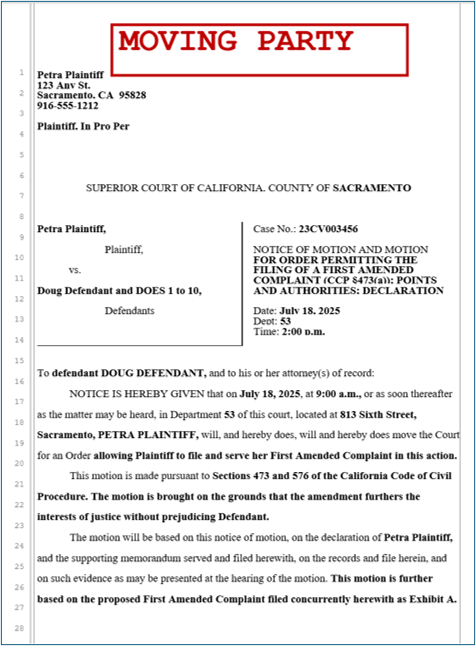
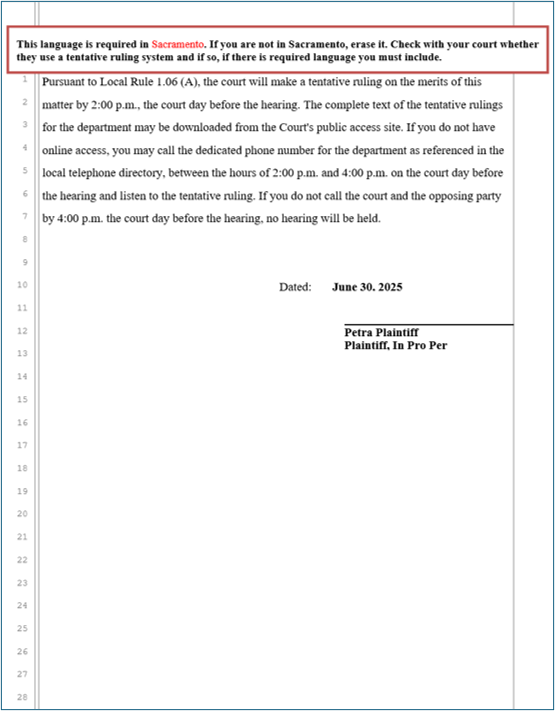

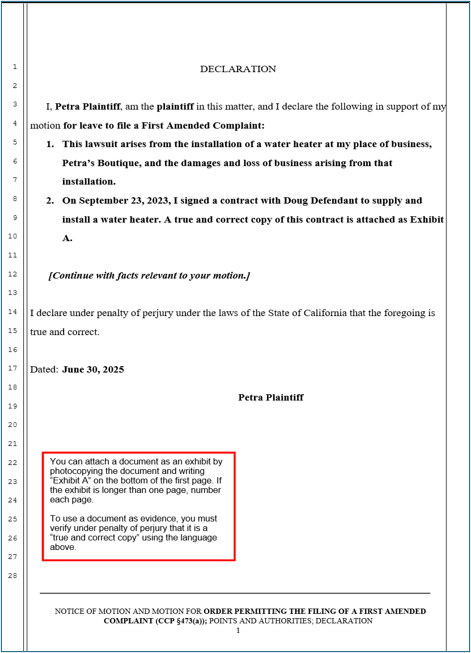
Proposed Order

Opposition or Reply
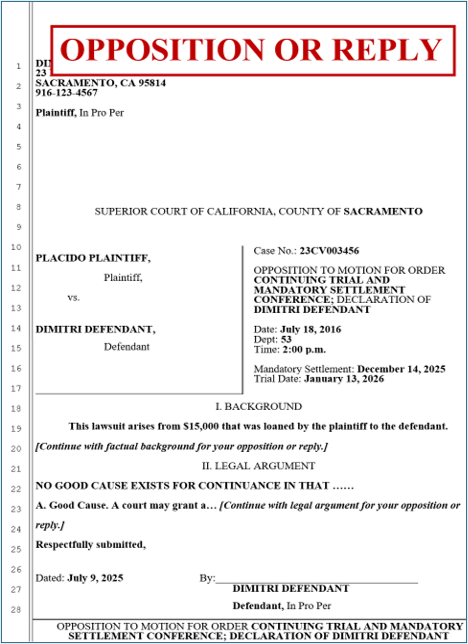
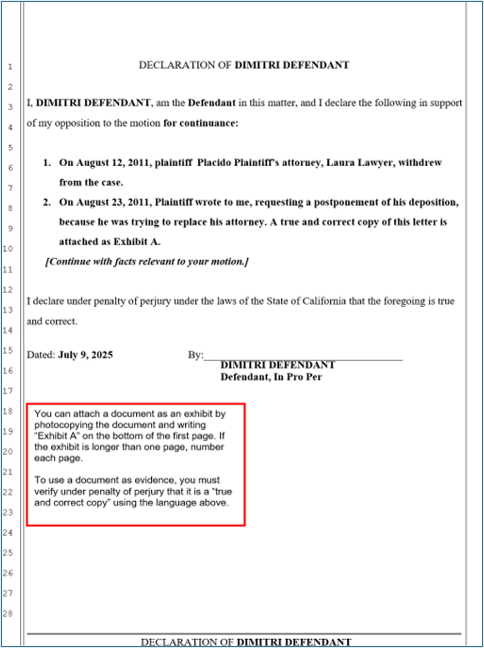
This material is intended as general information only. Your case may have factors requiring different procedures or forms. The information and instructions are provided for use in the Sacramento County Superior Court. Please keep in mind that each court may have different requirements. If you need further assistance consult a lawyer.




